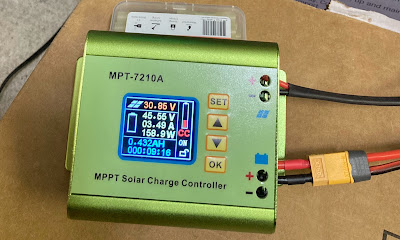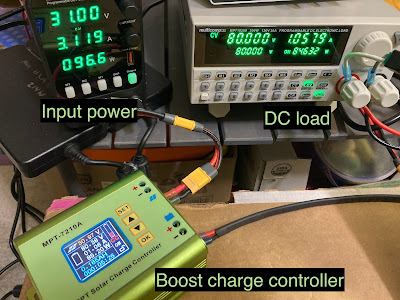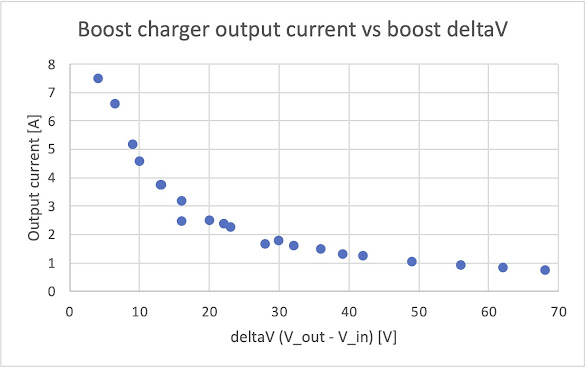In normal solar power systems used to charge batteries, the solar panel voltage is higher than the battery voltage, and a traditional charge controller can then be used. Sometimes, you want to charge a battery that has a higher voltage than your panels, though, such as an ebike battery with a small solar panel. For that you need a boost charge controller or boost converter. Very few are available, and the most common seems to be the MPT-7210A "MPPT" charge controller. It can also be used to turn any DC power supply (even a free cast-off laptop charger) into a battery charger.
 |
| The MPT-7210 boost charge controller |
I say MPPT in quotes because the MPT-7210A does not actually do Maximum Power Point Tracking. But it is still a valuable tool -- it is basically a programmable boost converter that has a setting for the minimum input voltage to use. That way, as it ramps up power and the voltage of your solar panels is pulled down, it does not just keep increasing current and collapse the input voltage to zero like a normal boost converter would do, but instead stops when the voltage is pulled down to your setpoint. See my previous post on DIY power stations for more discussion on how MPPT technology works.
How the MPT-7210A works
The MPT-7210A is described as a 10A/600W unit, but many of the reviews comment that they cannot actually get 10A or 600W out of it. For example, when supplied 12V, only a small amount of current (6.5A) is used to charge a battery at 54V, only providing 1.24A/67W of charging power. Where is the 600W?!
The answer lies in the internal limitations of the boost converter design. To get more current at the output, the input and output voltage need to be closer together. In the example of charging a 54V battery, a 48V input allows for 6.6A/360W of charging power. Much better! A 52V input would do even more power.
 |
| Charging a battery using a DC power supply |
Testing the capabilities of the MPT-7210A
Mapping out the input/output voltage and current for a variety of scenarios gives the following results. I used a DC power supply for the input, always with more current available than the MPT-7210A would take. The 13s data was collected by charging one of my actual 13s (48V) packs. The rest was taken using a DC electronic load, the Multicomp Pro MP710259, instead of a battery.
| Application | V_in [V] | I_in [A] | P_in [W] | V_out [V] | deltaV [V] | I_out [A] | P_out [W] | efficiency [-] |
| 7s 25.9V nom 29.4V max | 12 | 6.83 | 82 | 28 | 16 | 2.46 | 69 | 84.0% |
| 18 | 7.96 | 143 | 28 | 10 | 4.6 | 129 | 89.9% | |
| 24 | 9.6 | 230 | 28 | 4 | 7.51 | 210 | 91.3% | |
| 10s 37V nom 42V max | 12 | 6.58 | 79 | 40 | 28 | 1.66 | 66 | 84.1% |
| 18 | 5.92 | 107 | 40 | 22 | 2.37 | 95 | 89.0% | |
| 24 | 5.82 | 140 | 40 | 16 | 3.18 | 127 | 91.1% | |
| 31 | 7.16 | 222 | 40 | 9 | 5.17 | 207 | 93.2% | |
| 13s 48.1V nom 54.6V max | 12 | 6.6 | 79 | 54 | 42 | 1.24 | 67 | 84.4% |
| 18 | 5.1 | 92 | 54 | 36 | 1.48 | 80 | 86.9% | |
| 24 | 4.44 | 107 | 54 | 30 | 1.78 | 96 | 90.0% | |
| 31 | 4.31 | 134 | 54 | 23 | 2.27 | 122 | 91.7% | |
| 41 | 5.3 | 217 | 54 | 13 | 3.75 | 203 | 93.4% | |
| 48 | 7.79 | 374 | 54 | 6 | 6.6 | 360 | 96.2% | |
| 20s 74V nom 84V max | 12 | 6.24 | 75 | 80 | 68 | 0.75 | 60 | 80.1% |
| 18 | 4.41 | 79 | 80 | 62 | 0.83 | 66 | 83.6% | |
| 24 | 3.6 | 86 | 80 | 56 | 0.92 | 74 | 85.2% | |
| 31 | 3.12 | 97 | 80 | 49 | 1.06 | 85 | 87.7% | |
| 41 | 2.87 | 118 | 80 | 39 | 1.32 | 106 | 89.7% | |
| 48 | 2.92 | 140 | 80 | 32 | 1.6 | 128 | 91.3% | |
| 60 | 3.56 | 214 | 80 | 20 | 2.51 | 201 | 94.0% | |
| 67 | 4.69 | 314 | 80 | 13 | 3.74 | 299 | 95.2% |
 |
| Test setup for determining the max input/output current for a given set of input/output voltages |
So, the unit works, but this behavior is not very convenient if you want to charge a high voltage battery with a relatively low voltage source. The max power point voltage of a solar panel is typically in a pretty narrow range and not adjustable. But you can use the table and the following chart to estimate how much charging performance you can get. No matter how much solar or DC power is available, this is the max the unit will output.
 |
| MPT-7210A output current vs input-output voltage difference |
 |
| High power charging is possible! Requires an input voltage very close to the output voltage. |
Conclusion
The MPT-7210A boost charge controller works, but you have the understand the limitations to avoid getting frustrated with it. It can only charge with high power when the input voltage is close to, but still below, the output voltage.
That said, I'm still not totally sold on this thing. To avoid some of the trouble, you can also charge batteries with a standard bench power supply. For obscure solar setups the MPT-7210A is probably needed, but oddly there is no way to stop charging once current reaches some low threshold (indicating a fully-charged lithium ion battery). That's means you can't really let it charge unattended unless you are certain the battery won't ever fully charge. An odd device.
Possible alternative products: This no-name one (does not appear to accept a DC power supply input), and a Drok boost converter.
Have you used any of these units? What did it take to get it working well?
-Mike

Thanks for the post Mike, it was revealing as I was considering purchasing this for the same purpose. Instead i bought the "mppt" no name 300w device you linked to on Amazon. This one has no current limit at all which unfortunately means it can't be used to charge from a DC source unless your source has a constant current function like an adjustable bench supply (or solar panel of course--within the power limits).
ReplyDeleteAwésome, that'c exactly what i am looking for. I cave a chinese scooter, 1,2kW, 60V 1,2kWh battery (could fit nother but is enough.)
ReplyDeleteI have bought a 7210A a while go, and I thought about using it to charge my eBike (36V) and 60V Scooter battery. I basically mage the right choice in buying a 120W 40V Vmp foldable solar panel for it and I am thinking of buying a 160W to put in parallel for 280W.Thanks to your work, I know know that 40V Vmp/65V Battery max charge voltage, I am looking at 93% efficiency at start of charge 55V, and 216 W in max, reducing to 90% and 140W when it's full. A bit disappointing.
Awesome that your found this useful!
DeleteI decided to buy a CTK300-II MPPT Boost Controller for 40€. It works like charm, and I already have charged my battery with it.
DeleteHere are some images. About 93% efficient.
https://www.elektroroller-forum.de/viewtopic.php?p=274880#p274880
Hi
ReplyDeleteGood day to you
1.How many input amps is for the mpt-7210a charge controller?
2. What the calculation to figger the input amps for a solar charger controller?
I'm on this train too, now eskate w/ small+stout Lipo packs as my main power, with a large flaccid (can't handle heavy current) cylindrical Lithium Ion pack as a range extender... Charging the main pack through an MPT7210A for my 12S boards, through the "no name" unit listed here for my 16S board. I can confirm that output power/current is a factor of Vdiff between the 2 packs as shown here. For OTG charging to work, the charge rate needs to equal your *average* current draw for the ride... Lower and the main pack slowly drains. Using a 12S pack to boost a 12S pack I've had good results, soured only by a crappy 15A/8A Daly BMS letting out the magic smoke with 8.5A of charging current run through it. Using a 10S pack or 19.5V brick to power the MPT7210A while charging a 12S or 16S pack is limited to the above math... Tough go get more than few amps charging current. So, this charging scheme works great with a panel (or extender pack) close to (but LESS than) the main pack voltage.... Exactly the point of this article. I have one of the Drok units + something similar from a competitor with pots to adjust V and I. Both are rated at 600-800W, may be a better solution to this problem (mobile *smart* charging.)
ReplyDeleteWill this work to take 40 or 60V of solar and reduce it to 14.6 V for a lifepo battery?
ReplyDeletehi. self tought "electrician" here. I have blown up many of gadgets, including one of these (by trying to power it by a small 24v wind generator🫤) i still have a second MPT-7210A. now i'm bit cautios to attach a 48v battery straight into the secobd working thing as a power source and boost power to needed 60v. can one do that? because... when i did the same thing using the broken one, the thing (the power input) started to short circuit giving a nice spark and destroying a plug 🫤... i do not want brake my chinese gadgets that still work anymore... 🙏
ReplyDelete[quote]there is no way to stop charging once current reaches some low threshold (indicating a fully-charged lithium ion battery). That's means you can't really let it charge unattended[/quote]
ReplyDeleteNot sure what gets you to this conclusion. You can set the peak voltage and it won't go above that. So if you have a 17S battery and set the Voltage to 71.4V, it will fully charge the battery and then stop. And yes, I do this unattended, because if anything goes wrong, the BMS is still taking care of the pack
That conclusion came because while yes, a charge voltage cutoff can be set, a charge current cutoff is not an option. For example, the datasheet for the Samsung 21700 50E cell says:
Delete"This "Standard Charge" means charging the cell with charge current of 0.5C (2,450mA) and constant voltage 4.2V and 0.02C(98mA) cut-off in CV mode at 23°C."
That low current cutoff, commonly ~100mA, is what is needed for a complete proper charge cycle. For DIY projects, a time cutoff can get us pretty close but it's not ideal.